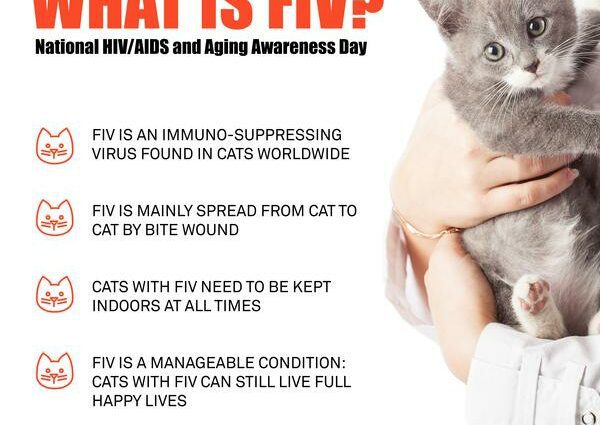Contents
Cat AIDS: what is a positive cat or FIV?
Cat AIDS is a disease caused by a virus, the Feline Immunodeficiency Virus or FIV (Feline Immunodeficiency Virus). This highly contagious disease is responsible for a weakening of the immune system. The cat suffering from the cat’s AIDS thus finds itself more fragile in the face of pathogens and can then develop secondary diseases. Having a cat with this disease requires certain precautions to be taken.
Cat AIDS: explanations
The feline immunodeficiency virus is one of the lentiviruses, a kind of virus with slow infection (hence the prefix “lenti” which comes from the Latin slow meaning “slow”). Like any virus, when it enters an organism, it needs to enter cells in order to multiply. In the case of cat AIDS, FIV attacks the immune cells. Once it uses these cells to multiply, it destroys them. We therefore understand why an infected cat ends up with a weakened immune system, it is said to be immunocompromised.
This disease is very contagious but it only affects cats (more generally felines) and cannot be transmitted to humans or other animals. Since FIV is present in the saliva of an infected cat, it is then transmitted directly to another cat during a bite, in the vast majority of cases. Transmission by licking or contact with saliva is also possible, although rare. This disease is also sexually transmitted during mating. In addition, transmission from an infected cat to her young is also possible.
Stray cats, especially uncastrated males, are more likely to be affected by fights and therefore a higher risk of bites.
Symptoms of cat AIDS
Phase 1: acute phase
Once the virus is present in the body, a first so-called acute phase takes place. The cat may show some general symptoms (fever, loss of appetite, etc.) as well as swelling of the lymph nodes. The body thus reacts to an infection by a virus. This phase is short and lasts from a few weeks to a few months.
Phase 2: lag phase
Then, a latency phase during which the cat does not show symptoms (asymptomatic cat) occurs in a second time. Nevertheless, during this period, although the cat does not show any symptoms, it remains contagious and can transmit the virus to other cats. As the name suggests (lentivirus), this phase is long and can last from a few months to several years.
Phase 3: onset of symptoms
This phase occurs when the virus wakes up and begins to attack cells. The cat is then progressively immunocompromised and its general condition deteriorates. Without an operational immune system, it is more fragile in the face of pathogens. Thus, some of the following symptoms may be observed:
- Mouth: inflammation of the gums (gingivitis) or even of the mouth (stomatitis), possible presence of ulcers;
- Respiratory system: inflammation of the nose (rhinitis) and eyes (conjunctivitis);
- Skin: inflammation of the skin (dermatitis), possible presence of abscess;
- Digestive system: inflammation of the intestine (enteritis), vomiting, diarrhea.
General clinical signs may also be present such as loss of appetite, fever or weight loss.
Phase 4: Acquired Immune Deficiency Syndrome (AIDS)
This is the terminal phase in which the cat’s immune system is severely weakened. The prognosis becomes bleak and serious illnesses such as cancer can set in.
Tests now allow us to know if a cat has cat AIDS. These tests look for the presence of antibodies to FIV in the blood. If there is indeed the presence of anti-FIV antibodies, the cat is said to be positive or seropositive. Otherwise, the cat is negative or seronegative. A positive result deserves to be confirmed by another test in order to see if the cat was not a false positive (positive result of the test even though it does not have FIV).
Cat AIDS Treatment
Treatment for cat AIDS primarily involves treating the symptoms that the cat is exhibiting. Unfortunately, it is important to keep in mind that when a cat is positive for FIV, it will keep it for the rest of its life. Antiviral treatment with an interferon is possible and can reduce certain clinical signs, but it does not completely cure an affected cat.
However, some cats can live with this disease very well. In all cases, special precautions must be taken. The goal is to prevent an HIV-positive cat from being exposed to pathogens so that it does not develop secondary disease. Thus, the following measures can be implemented:
- Exclusive indoor life: not only does this prevent the infected cat from coming into contact with pathogens present in the environment, but it also prevents the cat from transmitting the disease to its congeners;
- A balanced diet: a good diet allows you to preserve your immune system;
- Regular veterinary checks: these checks, ideally to be carried out every 6 months, make it possible to check the state of health of the cat. It is possible to carry out one or more additional examinations.
Unfortunately in France, there is currently no vaccine to prevent the onset of this disease. The only prevention remains sanitary within shelters and associations by separating FIV positive cats from other cats. It is also worthwhile to carry out a screening test for any new cat arriving in your household. Castration of male cats is also recommended insofar as it reduces aggression and therefore prevents bites.
In addition, it is important to keep in mind that FIV is one of the crippling vices in cats. You therefore have a legal withdrawal period if the cat you have purchased shows signs of this disease. Find out quickly from your veterinarian.
In any case, do not hesitate to contact your veterinarian if you have any questions about the feline immunodeficiency virus.










